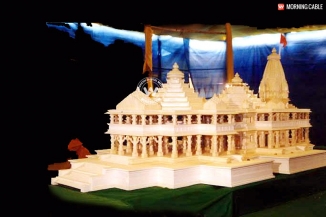
The town of Tirupati (Tiru Pati - Husband of Lord Venkateswara) is one of the most ancient and spectacular places of pilgrimage in India. It is situated in the Chittoor district in the southern part of the state of Andhra Pradesh, India. Tirupati is well connected with road, rail and air. Tirumala (Tiru Mala - Hill of Lord Venkateswara) Hill is 3200 ft above sea level and is about 10.33 sq miles in area.
Tirumala is the abode of Lord Sri Venkateswara or Balaji or Srinivasa and it comprises of seven peaks, representing the seven hoods of Adisesha or Anantha (bed of Lord Vishnu), thus earning the name, Seshachalam. The seven peaks are Seshadri, Neeladri, Garudadri, Anjanadri, Vrishabhadri, Narayanadri and Venkatadri.
The ancient and sacred temple of Sri Venkateswara is located on the seventh peak, Venkatadri (Venkata Hill) of the Tirumala Hill, and lies on the southern banks of Sri Swami Pushkarini. The Sastras, Puranas, Sthala Mahatyams and Alwar hymns unequivocally declare that, in the Kali Yuga, one can attain mukti (salvation), only by worshipping Venkata Nayaka or Sri Venkateswara.
The temple has its origins in Vaishnavism, an ancient sect which advocates the principles of equality and love and prohibits animal sacrifice. Sri Venkatachala Mahatmya is referred in several Puranas such as Varaha Purana, Padma Purana, Garuda Purana, Brahmanda Purana, Markandeya Purana, Harivamsa, Vamana Purana, Brahma Purana, Brahmottara Purana, Aditya Purana, Skanda Purana and Bhavishyottara Purana., of which the most important are the Varaha Purana and the Bhavishyottara Purana.
History
All the great dynasties of rulers of the southern peninsula have paid homage to Lord Sri Venkateswara in this ancient shrine. The Pallavas of Kancheepuram, the Cholas of Thanjavur, the Pandyas of Madurai, and the kings and chieftains of Vijayanagar were all devotees of Lord Sri Venkateswara. Sri Krishnadevaraya had statues of himself and his consorts installed at the portals of the temple and these statues can be seen to this day. There is also a statue of Venkatapati Raya in the main temple.
After the decline of the Vijayanagar dynasty also, nobles and chieftains from all parts of the country continued to pay their homage and offer gifts to the temple. The Maratha general, Raghoji Bhonsle, visited the temple and set up a permanent endowment for the conduct of worship in the temple. He also presented valuable jewels to the Lord, including a large emerald which is still preserved in a box named after the General. Among the later rulers who have endowed large amounts are the rulers of Mysore and Gadwal.
After the fall of the Hindu kingdoms, the Muslim rulers of Karnataka and then the Britishers took over and many of the temples came under their supervisory and protective control. In 1843 AD, the East India Company divested itself of the direct management of non-Christian places of worship and native religious institutions. The administration of the shrine of Sri Venkateswara and a number of estates were then entrusted to Sri Seva Dossji of Hatiramji Mutt at Tirumala and the temple remained under the administration of the Mahants for nearly a century, till 1933 AD.
In 1933, the Madras Legislature passed a special act, which empowered the Tirumala Tirupati Devasthanams (TTD) Committee to control and administer a fixed group of temples in the Tirumala-Tirupati area, through a Commissioner appointed by the Government of Madras. In 1951, the Act of 1933 was replaced by an enactment whereby the administration of TTD was entrusted to a Board of Trustees and an Executive Officer was appointed by the Government. The provisions of the Act of 1951 were retained by Charitable and Religious Endowments Act, 1966.
Stories related to Lord Venkateswara of Tirumala
The legends taken from Venkatachala Mahatmya and Varaha Purana, pertaining to the manifestation of Lord at Tirumala, are of particular interest. According to Varaha Purana, Adi Varaha manifested himself on the western bank of the Swami Pushkarini, while Vishnu in the form of Venkateswara came to reside on the southern bank of the Swami Pushkarini.
Rangadasa, a staunch devotee of Vishnu, in the course of his pilgrimage, joined Vaikhanasa Gopinatha, who was going up the Tirumala Hill for daily worship of Lord Venkateswara. After bathing in the Swami Pushkarini, he beheld the lotus-eyed and blue-bodied Vishnu beneath a tamarind tree. Vishnu was exposed to the sun, wind and rain and was only protected by the extended wings of Garuda. Rangadasa was astounded by the wonderful sight. He raised a rough wall of stones around the deity, and started supplying flowers faithfully to Gopinatha everyday for Vishnu's worship.
One day, Rangadasa was distracted by a Gandharva king and his ladies and he forgot to supply flowers to Gopinatha for Vishnu's worship. The Lord then revealed himself and told Rangadasa that he had been testing the latter's continence, but Rangadasa had not been steadfast and had succumbed to temptation. However, the Lord accepted and appreciated Rangadasa's devoted service to him till then and blessed Rangadasa that he would be reborn as an affluent ruler of a province and would enjoy the earthly pleasures. He would continue to serve the Lord, construct a beautiful temple with a vimana and high surrounding walls, and thereby earn eternal glory.
Rangadasa was reborn as Tondaman, the son of the royal couple, Suvira and Nandini. Tondaman enjoyed a pleasurable life as a young man. One day, when he set out on a hunting expedition on the Tirumala Hill, he saw Lord Vishnu under the tamarind tree. Tondaman returned home, deeply affected by the vision of Lord Vishnu. Tondaman later inherited his father's kingdom and he constructed a prakaram and dvara gopuram, and arranged for regular worship of the Lord Venkateswara.
Legend
During the eight thousand yugas (the equivalent of a day and night for Brahma, the Creator), there was a raging fire, and everything on Earth was reduced to ashes. At the approach of night (of Brahma), Vayu, the Wind God, blew furiously. Huge clouds were formed, there was torrential rain and it resulted in Pralaya Kalpa (the Great Deluge). The Earth sank into the Patala loka and remained in that state for a thousand years (which is only a part of that night of Brahma).
As per the prayers of Devas, Sri Maha Vishnu assumed the form of Adi Varaha and proceeded to Patala loka. He fought a fierce duel with Hiranyaksa and killed him and brought up the Earth on his tusks. Brahma, the Devas and the sages extolled Adi Varaha's virtues, by chanting the Vedic mantras. They prayed to him to re-establish the Earth as before. Adi Varaha called upon Brahma to recreate the world and expressed his desire to reside on the Earth to protect its people. Adi Varaha appeared with four arms and a white face. He was adorned with jewels and accompanied by Bhu Devi. He resolved to stay at Venkatadri, under a divya vimana, to grant the prayers of devotees.
Once when Narada was traveling he saw several rishis were performing a sacrifice. Narada asked them to whom they are going to give the fruits of their sacrifice. The rishis were not able to decide. So they asked Bhrigu, one of the rishis to solve the problem by examining the three chief divinities.
He first went to Satyalokam, the abode of the Brahma and found him busily chanting the Vedas with one face, uttering the name of Narayana with another and looking at Goddess Saraswati with the third. He took no notice of Bhrigu. Bhrigu was angry and cursed Brahma that nobody will worship him.
Bhrigu then went to Siva's abode (Kailasam). Here too, he found Siva is absorbed in intimacy with Sri Parvathy (wife of Lord Shiva) and he got angry seeing Bhrigu disturbing his privacy. Bhrigu was frustrated and cursed Lord Siva that people will not worship him in his form instead they will worship him in linga form.
Finally, Bhrigu went to Vaikuntam, the abode of Vishnu and found Vishnu and Sri Maha Lakshmi reclining on Adisesha. Disgusted, Bhrigu kicked Vishnu on the chest, where Sri Maha Lakshmi was reclining. Vishnu immediately got up, massaged rishi's foot and enquired whether his leg got injured. By seeing the reaction of Lord Vishnu taking care of him instead of scolding him, Bhrigu felt very bad for what he has done and apologized to Lord Vishnu. But Lord Vishnu consoled him and blessed him by keeping the mark of the kick of Bhrigu in his chest and it is known as “Sri Vatsamâ€. Pleased with Vishnu’s attention, Bhrigu returned to the rishis and advised them to dedicate the fruit of their sacrifice to Vishnu.
Sri Maha Lakshmi was angry with Bhrigu because he had kicked the spot which was her favourite resort on the bosom of the Lord. She left Vishnu and went to stay at Karavirapura (now Kolhapur in the state of Maharashtra). Unable to bear the solitude, Vishnu left Vaikuntam in search of Sri Maha Lakshmi. He made his way to Venkatadri, and entered the ant-hill under the tamarind tree on the southern bank of Swami Pushkarini on the Tirupati hill.
Taking pity on Lord Vishnu, Brahma and Maheshwara decided to assume the forms of a cow and its calf to serve Him. Surya, the Sun God informed MahaLakshmi of this and requested her to assume the form of a cowherdess and sell the cow and calf to the king of the Chola country. The king of the Chola country bought the cow and its calf and sent them to graze on the Venkata Hill along with his herd of cattle. Discovering Lord Vishnu on the ant-hill, the cow provided its milk, and thus fed the Lord.
Meanwhile, at the palace, the cow was not yielding any milk, for which the Chola Queen chastised the cowherd severely. To find out the cause of lack of milk, the cowherd followed the cow, hid himself behind a bush and discovered the cow emptying her udder over the ant-hill. Incensed over the conduct of the cow, the cowherd aimed a blow with his axe on the head of the cow. However, Lord Vishnu rose from the ant-hill to receive the blow and save the cow. When the cowherd saw the Lord bleed at the blow of his axe, he fell down and died of shock.
On the death of the cowherd, the cow returned, bellowing in fright and with blood stains all over her body, to the Chola King. To find out the cause of the cow's terror, the King followed her to the scene of the incident. The King found the cowherd lying dead on the ground near the ant-hill. While he stood wondering how it had happened, Lord Vishnu rose from the ant-hill and cursed the King saying that he would become an Asura because of the fault of his servant. The King pleaded innocence, and the Lord blessed him by saying that the curse would end when the Lord was adorned with a kireetam (Head Gear) presented by Akasa Raja at the time of his marriage with Sri Padmavathi.
Thereafter, Lord Vishnu or Srinivasa, decided to stay in Varaha Kshetra, and requested Sri Varahaswami to grant him a place for his stay. Srinivasa ordained that a pilgrimage to his shrine would not be complete unless it is preceded by a bath in the Pushkarini and darshan of Sri Varahaswami, and that pooja and naivedyam (offering) should be offered to Sri Varahaswami first.
Sometime later, a King named Akasa Raja who belonged to the lunar race was ruling over Tondamandalam. He had a brother named Tondaman. Akasa Raja had no heirs, and therefore, he wanted to perform a sacrifice. As part of the sacrifice, while he was ploughing the fields his plough turned up a lotus in the ground. On examining the lotus, the King found a female child in it. Akasa Raja was happy to find the child. He took the child to his palace and gave it to his Queen. At that time he heard a voice from above which said, "Oh! King, consider this girl child as your child and fortune will befall you." As the child was found in a lotus, the king named her Padmavathi.Â
In course of time, Princess Padmavathi grew up into a beautiful maiden and was attended to by a host of maids. One day, while she was spending her time in a garden picking flowers with her maids, Sage Narada approached her and asked her to show him her palm to read her future. He foretold that she was destined to be the spouse of Lord Vishnu himself.
At this time, Lord Srinivasa, who was hunting, chased a wild elephant in the forests surrounding the hills. In the elephant's pursuit, the Lord was led into a garden, where Princess Padmavathi and her maids were picking flowers. The sight of the elephant frightened the Princess and her maids. But the elephant immediately turned around, saluted the Lord and disappeared into the forest. Lord Srinivasa, who was following on horseback, saw the frightened maidens, who accosted him with queries. Lord Srinivasa gave the details about his birth and parentage. He, in turn, enquired after their princess, her birth and parentage.
When the maids informed Lord Srinivasa that the princess was Padmavathi, foster daughter of Akasa Raja, He expressed his interest in her. However, he was repulsed with stones thrown at him by the maids. He returned to the hills in haste, leaving his horse behind.
When Lord Srinivasa returned, Vakuladevi brought him his usual dinner comprising various delicacies. However, she found him lying on his bed, pining for his love. When she enquired about the cause, the Lord informed her that unless he married Princess Padmavathi, he would never be well again. Vakuladevi then asked him to tell her all about the Princess. The Lord then narrated the story of her (Padmavathi’s) previous birth and his promise to wed her.Â
Meanwhile, Akasa Raja and his queen Dharanidevi were anxious about the health of their daughter, Padmavathi. They learnt about Padmavathi's love for Srinivasa of Venkata Hill. Akasa Raja consulted Brihaspati about the propriety of the marriage and was informed that the marriage was in the behest of both the parties.
Vakuladevi promised Lord Srinivasa that she will go to Akasa Raja and ask for the hand of Padmavathi for Lord Srinivasa. After the departure of Vakuladevi, Srinivasa could not rest in peace. He doubted whether she would succeed in her mission. He, therefore, assumed the form of a lady fortune-teller and entered the streets of the capital telling fortunes. Padmavathi's maids saw her and invited her to the presence of their Queen. The fortune-teller read the palm of the Princess and told the Queen about the cause of Padmavathi’s indisposition. She advised the Queen to give Padmavathi in marriage to Lord Srinivasa. She also told the Queen that a lady would approach her shortly on behalf of Lord Srinivasa, to formally request Padmavathi’s hand in marriage. After the departure of the fortune-teller, Vakuladevi arrived at the palace, and was taken by the maidservants to the Queen. She informed the Queen that she had come on behalf of Lord Srinivasa to request the hand of Padmavathi in marriage.
Having consulted Brihaspati and heard from his Queen about the prediction of the fortune-teller and the arrival of the messenger from Srinivasa, Akasa Raja decided to give hand of his daughter in marriage to Srinivasa. He asked the palace purohits to fix an auspicious time for the marriage. Akasa Raja informed his ministers and other officials of his plans. Immediately, a letter was drafted requesting Srinivasa to come and marry the Princess.
Akasa Raja entrusted the delivery of the letter to Sukamahamuni. Suka went to Venkata Hill with Vakuladevi. He presented the patrika to Lord Srinivasa, who was very happy. The Lord sent his garland for Padmavathi through Suka.
Kubera lent money to Lord Srinivasa to meet the expenses of the marriage. Lord Srinivasa, along with his consorts and Lord Brahma and Lord Siva started the journey to the residence of Akasa Raja in his vehicle Garuda. At the palace entrance, Lord Srinivasa was received by Akasa Raja with full honours and taken in procession on a mounted elephant to the palace for the marriage. In the presence of all the Devas, Lord Srinivasa wed Princess Padmavathi, thus blessing Akasa Raja.
The temple of Lord Srinivasa in Tirumala is known as the richest temple and devotees used to donate their best possible to Lord Venkateswara. It is believed that, during the marriage of Lord Venkateswara with Padmavathi, Lord Venkateswara has borrowed money from Kubera to meet the marriage expenses. It is said that Lord Venkateswara is still repaying the debt with interest to Kubera and he needs more money to repay Kubera. That’s why devotees are helping Lord Venkateswara to repay by donating to Lord Venkateswara.
Places to be seen in Tirumala
The trip to Tirumala can be completed only after visiting other holy places in and around Tirumala such as Papavinasam, Akasaganga, Japali Hanuman Temple and Sri Venugopalaswamy Temple. It starts with Sri Venugopalaswamy Temple and ends at Papavinasam. It will be convenient for one to go to Papavinasam first and have a bath in the falls and then proceed to Akasaganga then to Japali Hanuman Temple and at last to Sri Venugopalaswamy Temple. There are frequent buses from Tirumala to Papavinasam
Papavinasam falls
Devotees can take bath in the falls in Papavinasam. It is believed that taking bath in Papavinasam will clear off one from all the sins committed till then. Water is supplied to the temple town from the reservoir at Papavinasam. The place is well maintained with parks and greenery around.
Akasaganga Falls
Akasaganga is a waterfalls and it is believed that, the water in the falls is generated from the holy Ganges. The source of the water cannot be located. Water comes out as natural stream here between the rocks. This sacred water is used for daily unction (abhisheka) of Lord Sri Venkateswara. One has to climb down the steps to reach this place.
Japali Anjaneya Swamy Temple and Teertham
There is a temple dedicated to Lord Hanuman, near Tirupati, 3kms from Gogarbham Dam. The temple is situated amidst lush green tall thick trees covering it like an umbrella. It is said that Lord Rama with his consort Sita and brother Lakshmana stayed here along with Lord Hanuman. The place came to know as Japali because Lord Hanuman did penance here. There is a perennial pond, called as Rama Kund, in the temple premises that was said to be the source of drinking water, during their stay here. There is a water source flowing to this place and it is not known where the water comes from.
There is another belief that after meeting Sita in Ravana’s Lanka Hanuman was very confused that whether he has to be happy that he was able to find out Sita or to be angry against Ravana for torturing Sita. Hanuman got down in this place on his way back to meet Sri Ram to inform about Sita’s plight in Lanka. Hanuman performed penance here to end the confusion and he was able to console his mind and felt very happy that mother Sita’s sufferings will be over once he informs Sri Ram and Sri Ram will go to Lanka to rescue mother Sita. Since he got peace of mind and felt happy in this place he blessed this place that anybody praying at this place will be able to find the supreme truth and will be blessed with what his wish is.
As per Hindu Mythology it is said that in all temples there must be Sri Ganesh idol and one has to enter the temple only after worshiping Sri Ganesh. This temple does not have a Ganesh idol so the devotees were not ready to worship in this temple and the temple became abandoned. Sri Ganesh got very sorry, that this place which is very sacred and which is blessed by Lord Hanuman himself is getting ignored. So he appeared in a tree in front of the temple. Now you can see the tree with growth in the bottom of the tree in the form of Sri Ganesh. It is believed that devotees who worship Japali Hanuman they will be blessed with Spiritual salvation, Brilliance and Physical strength.
Sri Venugopalaswamy Temple
This temple is under the control of Swamy Hatiramji trust. This temple is presently under renovation and the deity is being kept under a make shift temple. This deity is of Sri Krishna who is playing flute.
Temples in Tirupati
The must to be visited temple in Tirupati is of Sri Padmavathi at Tiruchanoor or Alamelumangapuram. The pilgrimage to Tirumala Sri Venkateswara Swamy has to start by visiting Sri Adi Varaha Swamy temple in the banks of Pushkarini in Tirumala and ends with the Darshan of Sri Padmavathi. Other important temples are also there in Tirupati which is a must to visit.
Tiruchanoor or Alamelumangapuram – Abode of Sri Padmavathi Devi
Tiruchanoor, also known as Alamelumangapuram, is about 5 km from Tirupati. The temple of Sri Padmavathi Devi, the consort of Lord Sri Venkateswara is situated here. It is said that a visit to Tirumala is fruitful only after visiting Sri Padmavathi Devi temple. It is also said a human being requires sanctity and prosperity in one’s life. So by worshiping Tirumala Sri Venkateswara one can achieve the sanctity in one’s life and by worshiping Sri Padmavathi one can achieve prosperity. When Sanctity and prosperity comes together one’s life becomes meaningful.
One may wonder why Sri Padmavathi Devi's temple is away from Lord Sri Venkateswara's. Legend has it that Lord (Sri Maha Vishnu, who later took on the incarnation of Sri Venkateswara) showed his reverence towards the sage, Bhrigu Maharishi, even though the sage had insulted Vishnu by kicking him on the chest. In anger, Sri Maha Lakshmi (the Lord's consort) reached Patala Loka, where she heard a divine voice stating that a pushkarini was dug on the banks of the river Swarnamukhi, and there she immersed herself in penance for 12 years.
In the 13th year (during the month of Karteeka, on Panchami day in the last fortnight, highlighted by the nakshathram Uttarashadha), Sri Padmavathi emerged from a golden lotus and was brought up by Akasaraja and then got married to Lord Venkateswara. It is believed that Goddess MahaLakshmi herself emerged as Sri Padmavathi.
Tirupati Sri Govindarajaswami Temple
Sri Govindarajaswami Temple is one of the most important temples in Tirupati. It has an imposing gopuram. Saint Ramanujacharya consecrated the temple in 1130 AD. The festivals and functions are similar to those conducted in the Sri Venkateswara temple. The annual Brahmotsavam at this temple is celebrated in the month of Vaisakha every year. The annual float festival is also celebrated every year.
Tirupati Sri Kodandaram Temple
This temple, which was built by a Chola king during the tenth century AD, is situated in the heart of the Tirupati town. The presiding deities are Sita, Rama and Lakshmana. The temple of Anjaneyaswami, which is directly opposite, is a sub shrine of this temple. According to legend, this temple commemorates the visit of Sri Rama to Tirupati. The festivals of Ugadi and Sri Ramanavami are celebrated in this temple on a grand scale. Brahmotsavam is celebrated at this temple every year.
Tirupati Sri Kapileswaraswamy Temple
Sri Kapileswaraswamy Temple is the only temple dedicated to Lord Siva in Tirupati. It is situated about 3 km to the north of Tirupati, at the foot of the Tirumala Hills. The sacred waterfall called Kapila Teertham (also known as Alwar Teertham) is located here. Annual Brahmotsavams and festivals like Vinayaka Chaturthi, Mahasivaratri, Skanda Shasti and Annabhishekam are performed here with great pomp and splendor.
By Premji




















